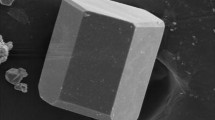Abstract
Three iron-rich 1:1 clay minerals, greenalite [Si2]{Fe 2+3 }O5(OH)4, berthiérine [Si, Al]2{Fe2, Mg, Fe3+, Al}3 O5(OH)4 and cronstedtite [Si, Fe3+]2{Fe2+, Fe3+}3O5(OH)4 have been studied by Mössbauer spectroscopy, magnetization measurements and neutron diffraction to determine their magneticproperties. The predominant magnetic coupling is ferromagnetic for pairs of ferrous ions in the octahedral sheet, but antiferromagnetic for ferric pairs. The crystal field at Fe2+ sites in greenalite and berthiérine is effectively trigonal with an orbital singlet l z=0 as ground state. These mainly ferrous minerals order magnetically at 17K and 9K respectively. The magnetic structure of greenalite consists of ferromagnetic octahedral sheets, with the moments lying in the plane, coupled antiferromagnetically by much weaker interplane interactions. The ratio of intraplane to interplane coupling is of order 50, so the silicate has a two-dimensional aspect, both structurally and magnetically. Although the overall magnetic order is established as antiferromagnetic by neutron diffraction, the magnetization curves resemble those of a ferromagnet because of the very weak interplane coupling. Cronstedtite orders antiferromagnetically around 10K. Moments within the planes are antiferromagnetically coupled. The magnetism has no particular two-dimensional character because exchange paths between the layers are provided by the ferric cations present in the tetrahedral sheets.
Similar content being viewed by others
References
Bacon GE (1975) Neutron diffraction, 3rd edn. Oxford University Press, Oxford
Bailey SW (1980) Structures of layer silicates. In: Brindley GW, Brown G (eds) Crystal structures of clay mineral and their X-ray identification. London, Mineralogical Society, pp 1–124
Ballet O (1979) Fe2+ dans les silicates lamellaires. Etude magnétique et Mössbauer. Thèse de troisième cycle, Grenoble
Borg RJ, Lai DYF, Borg IY (1973) Use of magnetic hyperfine splitting to determine Fe2+/Fe3+ ratios in complex silicate minerals. Nature (London), Phys Sci 246:46–48
Borg RJ, Borg IY (1974) Magnetic order in certain alkali amphiboles, a Mössbauer investigation. J Phys (Paris) 35:C6 553–556
Borg RJ, Borg IY (1980) Mössbauer study of behaviour of oriented single crystals of riebeckite at low temperatures and their magnetic properties. Phys Chem Minerals 5:219–234
Burns R (1970) Mineralogical applications of crystal field theory. Cambridge University Press, Cambridge
Coey JMD (1980) Clay minerals and their transformations studied with nuclear techniques: The contribution of Mössbauer spectroscopy. At Energy Rev 18:73–124
Coey JMD, Ballet O (1978) La greenalite: Argile métamagnétique. CR Acad Sci (Paris) 286:355–357
Goodenough JB (1963) Magnetism and the chemical bond. Interscience, New York
Herpin A (1968) Théorie du magnétisme. Presses Universitaires de France, Paris
Jacobs IS (1963) Metamagnetism of siderite (FeCO3). J Appl Phys 34:1106–1107
Kan XM, Zhang EL, Li YR (1980) Zeeman splitting in Mössbauer spectra of laihunite at low temperature. Kexue Tongbao 25:858–861
Kundig W, Cape JA, Lindquist RH, Constabaris G (1967) Some magnetic properties of Fe2SiO4 from 4°K to 300°K. J Appl Phys 38:947–948
Landa ER, Gast RG (1973) Evaluation of crystallinity in hydrated ferric oxides. Clays Clay Miner 21:121–130
Mermin ND, Wagner H (1966) Absence of ferromagnetism or antiferromagnetism in one or two-dimensional isotropic Heisenberg models. Phys Rev Lett 17:1133–1137
Miyamoto H, Shinjo T, Bando Y, Takada T (1967) Mössbauer effect of 57Fe in Fe(OH)2. J Phys Soc Japan 23:1421; Bull Inst Chem Res Kyoto Univ 45:333–341
Miyamoto H (1976) The magnetic properties of Fe(OH)2. Mater Res Bull 11:329–336
Morrish AH (1965) The physical principles of magnetism. Wiley, New York
Regnard JR (1976) Mössbauer study of natural crystals of staurolite. J Phys (Paris) 37:C6 797–780
Varret F, Hartmann-Boutron F (1968) Effects du couplage spin-orbite sur les propriétés des composés magnétiques ioniques du groupe du fer. Ann Phys 3:57–174
Varret F (1976) Crystal-field effects on high-spin ferrous ion. J Phys (Paris) 37:C6 437–456
Weber F (1973) Genesis and supergene evolution of the Precambrian sedimentary manganese deposit at Moanda (Gabon). Proceedings of the Kiev Symposion on Genesis of Precambrian Iron and Manganese Deposits 1970 (UNESCO), pp 307–324
Author information
Authors and Affiliations
Rights and permissions
About this article
Cite this article
Coey, J.M.D., Ballet, O., Moukarika, A. et al. Magnetic properties of sheet silicates; 1:1 layer minerals. Phys Chem Minerals 7, 141–148 (1981). https://doi.org/10.1007/BF00308232
Received:
Issue Date:
DOI: https://doi.org/10.1007/BF00308232




